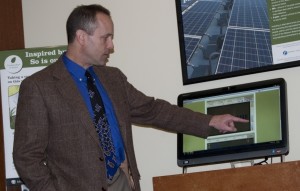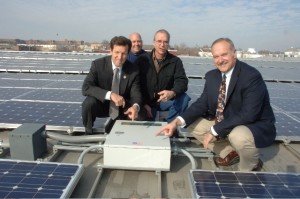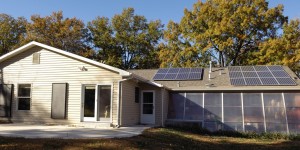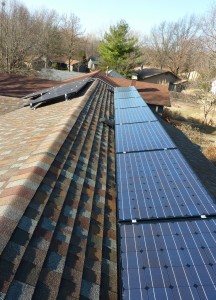For Missourians, the time to consider a solar energy system is now. The Missouri Clean Energy Initiative, passed overwhelmingly as Proposition C in 2008, requires that 15% of the state’s electrical power come from renewable sources by 2021. As a result of the Clean Energy Initiative, Missouri’s power companies are offering financial incentives to customers who help them meet that goal. ” Erin Noble of the Missouri Coalition to the environment points out that those incentives added to the 30% federal tax credit can reduce the initial cost of a solar installation by up to two-thirds.”
In addition, the cost of solar panels has come down about 30% in the last three years.
Solar Energy Use Becoming More Visible
Until recently solar panels have not been a frequent sight in Missouri. Ameren has only about 200 solar power producers integrated into its grid. (Most commonly, Ameren supplies the needed power to supplement solar production, and will buy excess power if solar production exceeds usage.)
Now solar panels are going public. The Missouri Botanical Garden recently installed a 25 kW array of 100 solar panels on its Commerce Bank Center for Science Education. The panels, given to the Garden by Express Scripts, will produce about 32,000 kW-hrs a year—about 5% of this large building’s electricity requirements, or enough electricity to power four to six average homes.

Photo courtesy of Missouri Botanical Garden
Visitors to the building can interact with a touch screen in the lobby. They will be able to see the real-time production of power, the daily energy harnessed, and tallies for weekly, monthly, and lifetime energy production.
Busch Stadium is also planning a solar installation on its plaza. With about 85 solar modules it will supply only a small fraction of the stadium’s power needs. However, it will serve as an educational device. An accompanying interactive display will show what the Cardinal organization is doing to save energy. “People will be prompted to think of what measures they can use in their own homes,” says the installer, Marc Lopata of Microgrid Energy of Clayton.
Economic Incentives for Solar Energy
Until recently, the main impetus for “going solar” was to make a green contribution. After all, the sun is the biggest source of energy around, and its rays are free. Solar power produces no pollution. Electricity production is highest when days are long and warm, coinciding with peak electrical usage for air conditioning. And each kW-h of solar power keeps about 2 pounds of carbon dioxide that results from coal combustion out of the air. That 25 kW system at the Botanical Garden will replace about 30 tons of carbon dioxide in a single year.
But until recently the upfront cost of producing solar power did not make economic sense for most homes and businesses.
Beginning in January, 2011, three financial incentives combine to reduce the purchase and installation of a solar unit by as much as two thirds.
- The federal 30% tax credit for solar system installation was extended until 2016 by the 2010 ‘lame duck’ congress.
- Power companies are awarding a rebate of $2 per watt of solar capacity installed up to 50 kilowatts (kW); thus, if a home or business in St. Louis purchases enough solar panels to produce 2 kW of electricity, Ameren must send them a check for $2000, as required by Proposition C.
- Ameren has set aside $2 million for the year 2011 to purchase solar renewable energy credits (SRECs) from the owners of 2-10 kW solar systems.
- These tradable credits are based on the amount of electricity produced annually, in kilowatt-hours. In Missouri, a 2 kW system will produce about 2600 kW-hrs of electricity, and the homeowner can sell the SREC for that power for $2600.
- 10-100 kW systems are metered, and can sell SRECs for the actual megawatt-hrs produced for the first five years after installation.
As an example, Erin Noble of the Missouri Coalition for the Environment, installed a small (about 2 kW) system on her roof in November of last year. The initial cost was $11, 600, but with tax breaks and Ameren incentives her final cost was only $3600.
For businesses, the solar system can be depreciated in only one year, giving an additional incentive.
95% Energy Cost Reduction for St. Louis warehouse
The largest solar power installation in Missouri was completed in November for the St. Louis warehouse of Walsh and Associates chemical distributors. This 100 kW system of 416 panels on the roof of their 88,000 square foot building culminates seven years of cost-saving through application of energy efficiency. Their annual electric bill has been reduced 95%.

Photo by Arteaga Photos, LTD
When Walsh first moved into its new warehouse on Macklind Avenue, explains Randall Lewis, director of operations, they were stunned to find their first year’s electricity has cost $35,000. They knew they needed to replace the HVAC in this old building. Doing so reduced the annual electric bill by 25%. $26,000 a year still seemed exorbitant.
Lighting for businesses is often responsible for about 30% of the electricity used. Lewis attended a lighting seminar at Meramec Community College where he learned about some new energy saving lights. With the first 52 lights he updated, the company immediately saved $250 a month with a payback of 6.7 months. And he was hooked on energy efficiency.
Since then, they replaced or retrofitted another 400 lighting fixtures, and added 50 Solatube light diffusers (www.solatube.com). After some other improvements, such as motion sensors, an energy audit found the building was about as efficient as conventional means could make it.
By 2009, however, the tax advantages and rebates were beginning to make solar power economically attractive—and they decided to go for it. Their system, designed by StraightUp Solar of St. Louis, was priced at $500,000. But with one-year depreciation, the 30% tax credit, the wattage rebate from Ameren, and the sale of SRECs, the actual cost was about $150,000.
With their annual electric bill now reduced to an estimated $1500 at today’s rates, the Walsh system will pay for itself in about 5 years. Solar panels have a lifetime of about 25 years, and the inverters that change the AC current they produce into DC usually have a 10-15 year guarantee. Thus for 5-10 years after payback, the solar system should make Walsh about $33,000 per year, and more if electrical rates increase.
Residential solar power becoming an option
The payback for residential solar electric systems is usually longer than for commercial. But, points out Dane Glueck of StraightUp Solar, since solar panels last at least 25 years, even a 15 year payback will eventually make money for the owner. And during the pay-off years, the return on investment from savings on electric bills is about 7%. He suggests thinking of it as locking in today’s rate. If rates go up—and Ameren has increased its rates 3 times since 2007—the payback will obviously be greater.
Furthermore, says Gleuck, “People need to realize that when you turn on your lights, you are burning coal.”

Photo by B. Waxman
Environmental awareness has been a strong motivator for Glueck’s residential customers.
Bernard Waxman of Olivette had done as much as he could to reduce the carbon footprint of their 2100 square foot ranch house. They had insulated, switched to compact fluorescent bulbs, and put computers and TVs on power strips so they could be turned off completely when not in use. In the 1970’s, tax credits had enabled him to put in a solar greenhouse that provided 40-60 % of the heat in his small ranch house. An addition to the house featured solar heating panels.
The new incentives allowed him to purchase a 2.76 kW solar system in February, 2010. That panel supplied 60% of their electricity. He felt he could go farther, and added another 2 kW’s worth of paneling. The electricity they use on cloudy days is compensated by the power they sell back to the grid during the long sunny days of summer.
Lee Grasfeder has a 5000 square foot home near Festus. He already used a geothermal system to heat and cool his house, using electricity to pump water from a well. Because the 55 degree well water cools his house in the summer, his ‘air conditioning’ cost is the well’s pump; the 5 kW solar system he installed eight months ago produced excess electricity in the summer.

Photo by John Gee
But in the winter the well water needs an auxiliary heater, so he is adding another 5 kW of solar power.
“I try to take a long term approach,” says Grasfeder. “I can’t understand why we stay addicted to oil when energy from the sun is free. And I think alternative energy is a great opportunity to put people to work.”
John Gee of Maryland Heights says “Watching your meter spin backwards is priceless.” The 3.5 kW solar system on his 1200 square foot house has reduced his electric bill by 45%.
“I wanted to show people it’s possible to do solar on a regular place, as a little bit of green leadership. The electricity I generate from solar power is coal Ameren doesn’t burn for me.”
The payback time for these residential units ranges from 12-16 years at today’s rates for electric power.
Not all residences are suited for solar energy, points out Lopata of Microgrid Energy. Shade from just three nearby trees can cut the output by 70%, and “We certainly don’t want to encourage people to cut down trees.” But homeowners can get an energy audit and strive to have an ‘energy star’ house.
Converting to solar energy for commercial properties with flat roofs, however, should be part of a business plan, according to Lopata. Especially now.
This article was originally published in the St. Louis Beacon.
